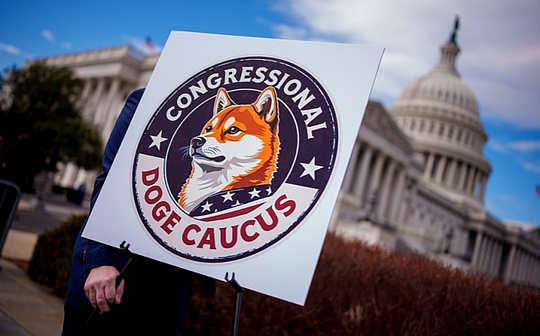
The U.S. Treasury Department recently announced plans to issue a $1 commemorative coin featuring President Trump, aimed at celebrating the 250th anniversary of American independence. However, this move has drawn strong opposition and criticism from several lawmakers. The coin's design distinctly highlights Trump's characteristics: the obverse features his portrait, while the reverse depicts him with a raised fist in front of the American flag, accompanied by the words "Fight, Fight, Fight." This has sparked intense debate over how U.S. official coins should be designed, particularly regarding political sensitivity.
Democratic Senator Chris VanHollen publicly expressed strong objections during a recent Senate Banking Committee nomination hearing. He questioned whether featuring a president's portrait on an official U.S. coin is even compliant with regulations. Moreover, he found it particularly troubling that the coin's design appears to have some connection to the Trump-endorsed meme coin—TRUMP. The name TRUMP coin is identical to the words "Fight, Fight, Fight" on the reverse of the commemorative coin, and this meme coin was launched by Trump just before his second inauguration in 2025.
As a social media culture-based digital currency, the TRUMP meme coin quickly attracted significant investor attention, particularly gaining market influence among Trump's political supporters. The company behind TRUMP coin leveraged Trump's fame to attract a large number of investors through political marketing, and its name coincidentally matches the design of the commemorative coin. VanHollen believes that the Treasury Department's move essentially serves Trump's political interests in an inappropriate manner, further heightening public concerns about potential conflicts of interest between the government and private interests.
In response to this issue, Paul Hollis, nominee for Director of the U.S. Mint, stated during the hearing that he is "100% committed to always following the law" and emphasized that the design process for the commemorative coin strictly adhered to relevant regulations, aiming to celebrate important national historical events. However, this response did not alleviate the lawmakers' dissatisfaction; instead, it intensified their concerns about the potential political controversy and legitimacy issues arising from this initiative.
The controversy surrounding this event extends beyond the commemorative coin itself, raising broader questions about how the government balances national symbols and political interests. The design and issuance of commemorative coins should ideally reflect national unity and historical heritage, but this move appears to introduce political divisions into a traditional domain of official memorabilia that ought to carry symbolic and historical significance. As this issue continues to develop, there may be further legal and policy discussions to ensure that similar problems do not undermine the government's credibility and the impartiality of policy implementation.
This incident demonstrates that in the current U.S. political environment, even the design of an ordinary commemorative coin can trigger profound political and legal debates. Regardless of the final decision, this event has undoubtedly deepened public concerns about potential intertwining interests between U.S. politics and the Treasury Department.
















